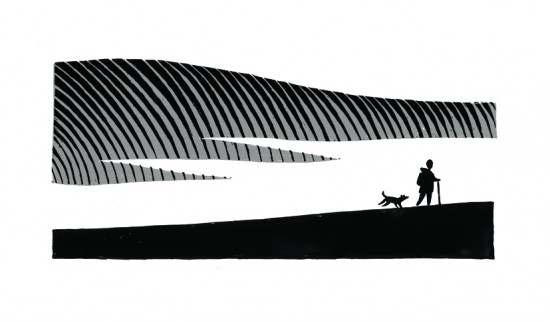 illustration by Jon McNaught
illustration by Jon McNaught
An extract from the new Caught by the River book, On Nature.
….my eye had been drawn to six or seven little hardback books that were obviously some kind of series. One was brown, another yellow, another green. They were handwritten and handdrawn, things of such painstaking elegance of design and craft that even though the subject – Cumbrian hills – didn’t much appeal, the sheer loveliness of them, plus the maps and the local info, made them treasurable. They seemed to be written by a bloke called Wainwright. I imagined he was a bit of an anorak.
Three decades on and on the shelf beside me are not one but two full sets of Alfred Wainwright’s Seven Volume Pictorial Guide To The Lake District Fells. Look closely at the two sets and you’ll notice a crucial difference that explains the need for both. One set is battered and dog-eared, stained with coffee and smeared with butter, stained with grass and dirt. The other is relatively pristine, the reason being that one is for the fireside and the other for the fellside, one sees action in the field, the other nothing more strenuous than being pored over whilst planning a day’s adventures.
Notwithstanding the disadvantage of being dead – he passed away in 1991 – Alfred Wainwright has had a good few years of late. There’ve been biographies and celebrations. There’s a society bearing his name. And thanks to the Wainwright Walks TV series, a new generation has been inspired to take to the hills and re-trace the steps he walked in between the late 50s and the mid 1960s when researching his famous guide books. The success of the shows was due in no small measure to the choice of presenter, the extremely personable Julia Bradbury, a refreshing choice after years of blokes from the Jack Hargreaves school of outdoors tv presentation; crusty, bearded, curmudgeonly.
All of which could be said to apply to Wainwright himself, or at least that’s the popular image. But he had his poetic side, one that drew him from the dark satanic mills of his native Blackburn to Kendal to be nearer his beloved hills. He’d have approved of Julia too. AW was a sucker for a pretty face. He was more than just that in fact; he was a true romantic. His love letters to his second wife Betty are mildly shocking in their intensity and tenderness, especially if you had him tagged as a harrumphing sourpuss. But if you know the books, you’ll know his lyrical and poetic side too. That’s the side that has made millions like me a devotee of his work, even when it was a love that dare not speak its name, such as my tenure as an NME writer, when a liking for anything more outdoorsy than the healing field at Glastonbury marked you out as a weirdo amongst weirdos.
Wainwright classified 214 separate fells as making up the mountain landscape of the Lake District. Pedants and purists grumble about his list saying that some such as Mungrisedale Common – a grassy pudding beneath the infinitely superior rocky throne of Blencathra – is not a separate fell at all and that Wainwright included it just to make up the numbers in book 6. This may be true. But now the list is canonical, and there are folk who will not rest until they have crested the summit of every one. I know because I am one. I’m not one of natures list tickers – I don’t collect records, I don’t keep a diary – but I decided to ‘do the Wainwright’s’ as it would be a ready made itinerary that would take me to every corner of the Lake District. It has been a long, strange brilliant trip to paraphrase the Grateful Dead. It has taught me loads about myself and others. It has made me laugh and cry. given me a treasure house of memories to be endlessly raided.
So where do you start? Go to the original volumes. There are any number of interpretations, re-workings, spins and spin-offs but no-one has improved on AW’s original pen and ink works. The art work is gorgeous, the writing hugely quirky and characterful as well as evocative. And though the occasional right of way may have changed, the mountains don’t. With decent gear, a 1;25000 OS Map and the relevant Wainwright, you should be able to tackle any of the 214 Wainwright’s even if you don’t have a beard. Wainwright was adventurous, but he was never foolhardy. He always has a word of sound advice for the novice fellwalker.